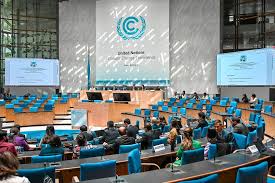Context:
The mid-year climate discussions concluded recently in Bonn, Germany with limited progress, thus raising concerns for a potentially bumpy road to COP29 to be held in Baku, Azerbaijan later this year.
More on the News
- The 60th session of the United Nations Framework Convention on Climate Change (UNFCCC) Subsidiary Bodies (SB60), also known as the Bonn Climate Change Conference, took place from June 3-13, 2024, in Bonn, Germany.
- These subsidiary body meetings serve as a crucial mid-point in the journey between major decision-making conferences, like COP28 in Dubai (2023) and the upcoming COP29 in Azerbaijan (later in 2024).
- SB60 aimed to pave the way for COP29 by tackling critical issues related to climate action. Discussions centered on establishing guidelines for carbon markets under the Paris Agreement (Articles 6.2 and 6.4), which remained unresolved at COP28.
- Another major sticking point was the New Collective Quantified Goal (NCQG) on climate finance for developing countries, as mandated by Articles 9.1 and 9.3 of the Paris Agreement.
Developing nations called for increased grant-based and concessional financing, while developed countries proposed including certain developing countries in the contributor base, arguing it reflects “new economic realities.”
Challenges to COP29
- Geopolitical Tensions: The ongoing war in Ukraine cast a long shadow on the Bonn discussions. With major emitters like Russia preoccupied with the conflict, there was a lack of urgency in addressing climate action.
- Focus on Mitigation Over Adaptation: While discussions on reducing greenhouse gas emissions (mitigation) received significant attention, issues crucial for developing countries, such as climate adaptation and financing, were overshadowed.
- Limited Progress on Key Issues: Substantive discussions on crucial topics like the Global Stocktake (assessment of progress towards climate goals) and the Warsaw International Mechanism for Loss and Damage (addressing impacts of climate change) witnessed minimal progress.
- Delivery of Climate Finance Pledges: Developed nations continue to lag behind on their promise of mobilizing $100 billion annually by 2020 to support climate action in developing countries.
India’s Stance and the Way Forward
- India has consistently called for a balanced approach that addresses both mitigation and adaptation needs.
- Focus on technology transfer and financial support from developed countries is crucial for developing nations to implement ambitious climate action plans.
- Civil society engagement and public pressure are essential to hold governments accountable for their climate commitments.
Conference of the Parties (COP)
- COP is the supreme decision-making body of the United Nations Framework Convention on Climate Change (UNFCCC). It brings together representatives from the 197 nations and territories (called Parties) that have signed the Convention.
Key functions of COP include:
- Review and Assessment: The COP reviews the implementation of the Convention and any other legal instruments it adopts. It assesses the effects of measures taken by Parties and progress toward the Convention’s ultimate objective.
- Annual Meetings: The COP meets annually to discuss climate-related matters, unless Parties decide otherwise. The first COP meeting was held in Berlin, Germany, in March 1995.
Upcoming COP 29
- Azerbaijan will host COP 29 from November 11-22, 2024.
- It will expand on the agenda established in COP 28 in Dubai.
Key Agenda Items:
- Building on COP 28’s agenda to achieve net zero by 2050 and transition away from fossil fuels.
- Securing consensus on limiting global warming to 1.5°C above pre-industrial levels.
- Addressing the unfulfilled $100 billion annual climate finance commitment from developed countries. This includes setting a new target above $100 billion and determining whether the funds will be grants or loans.
Articles 6.2 and 6.4 of the Paris Agreement
Both deal with international cooperation on climate change mitigation efforts, but they function in different ways:
Article 6.2:
- Allows countries to trade carbon credits directly with each other through bilateral agreements.
- These credits, called Internationally Transferred Mitigation Outcomes (ITMOs), represent verified emission reductions or removals achieved in one country that can be used by another country towards their own climate goals (Nationally Determined Contributions – NDCs).
- ITMOs can be measured in carbon dioxide equivalent (CO2e) or using other metrics like renewable energy generation (kWh).
- This approach allows countries with surplus emission reductions to sell them to countries that might struggle to meet their own targets.
Article 6.4:
- Establishes a new global carbon market overseen by the United Nations Framework Convention on Climate Change (UNFCCC).
- This market allows project developers to register emission reduction projects that meet strict environmental and social safeguards.
- If approved, these projects can generate tradable carbon credits that countries and entities can then purchase and use towards their climate goals.
- The goal is to ensure high-quality carbon credits and avoid issues seen in previous carbon market mechanisms.

